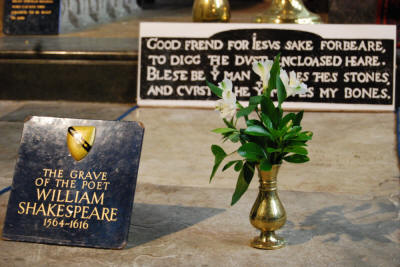| William Shakespeare is buried in the Holy
Trinity Church, Stratford-on-Avon, Warwickshire, England.
The church stands on the banks of the River Avon in a charming location.

Shakespeare's Grave
photo by Sinéad Kent
It is thought that
Shakespeare was born in Henley Street in Stratford in 1564 –
the son of John Shakespeare (a successful glove maker) and Mary Arden.
He was christened on the April 26 – but it is assumed that he was
actually born three days earlier on the 23 April. It is likely that he
attended the King Edward VI Grammar School in Stratford where he would
probably have received tutoring in Latin and Greek.
In 1582 he married
Anne Hathaway – who was already pregnant at the time – and their
daughter Susanna was born in 1583. The couple later had twins – Hamnet
and Judith in 1585 - but unfortunately Hamnet died at the age of 11 in
1596.
By the end of the
century, Shakespeare is known to have moved to London and was pursuing a
career as an actor and a playwright. In 1598 he appeared in Every Man
in His Humour by Ben Jonson and later he joined the Lord Chamberlain's
Men working alongside the actor Richard Burbage.
Shakespeare, like his contemporaries Marlowe
and Jonson, is chiefly remembered for his dramatic works -
yet he was an inspired poet. His sonnet sequence
- consisting of 154 separate poems - is arguably the finest collection
of love poems in the English language. It is also one of the most
mysterious as, even today, after intensive study, we still do not know
the identity of 'Mr W. H.' ( 'the onlie begetter of these insuing
sonnets') - nor
that of the 'Dark Lady' or young man who inspired them. His other
major poems include: Venus and Adonis (1593), The Rape of
Lucrece (1594) and A Lover's Complaint (1609).
Shakespeare's last
play The Tempest was performed in 1611, though he
collaborated on 3 others after that date. He probably retired to Stratford
in 1613.
It is said that Shakespeare contracted a fever
following a drinking binge with Ben Jonson and Michael Drayton.
It is also rumoured that, on his deathbed, he reverted to catholicism. He
died on his birthday - the 23 April 1616 (St George's Day) at the age of 52. |







